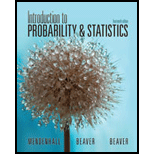
(a)
To complete: the ANOVA table.
(a)
Answer to Problem 11.5E
The Analysis of Variance is given by,
| Source | ||||
| Treatments | ||||
| Error | ||||
| Total |
Explanation of Solution
Given:
Calculation:
We know that,
| Source | ||
| Treatments | ||
| Error | ||
| Total |
Now, calculate,
Therefore, the Analysis of Variance is given by,
| Source | ||||
| Treatments | ||||
| Error | ||||
| Total |
Conclusion: Therefore, the Analysis of Variance is given by,
| Source | ||||
| Treatments | ||||
| Error | ||||
| Total |
(b)
To find: the number of degrees of freedom associated with the F statistic.
(b)
Answer to Problem 11.5E
The degrees of freedom are associated with the F statistic for testing
Explanation of Solution
Given:
Calculation:
To test the null hypothesis,
Versus the alternative hypothesis,
We have,
And we know that,
The test statistic is,
And this test statistic has an F distribution with
Conclusion: Thus, the degrees of freedom are associated with the F statistic for testing
(c)
To give: the rejection region for the test in part b for
(c)
Answer to Problem 11.5E
There is sufficient evidence to indicate that at least one of the four treatment means is different from at least one of the others.
Explanation of Solution
Given:
Calculation:
Rejection region:
Using the critical value approach with
Since,
The observed value,
Therefore, we conclude that, there is sufficient evidence to indicate that at least one of the four treatment means is different from at least one of the others.
Conclusion: There is sufficient evidence to indicate that at least one of the four treatment means is different from at least one of the others.
(d)
To find: whether the given data is an evidence to indicate differences among the population means.
(d)
Answer to Problem 11.5E
There is sufficient evidence to support the claim that there is a difference in the population means.
Explanation of Solution
Given:
Calculation:
If the value of the test statistic is within the rejection regions, then the null hypothesis is rejected.
From part c, rejection region contain all values greater than or equal to
From part a,
Yes,
There is sufficient evidence to support the claim that there is a difference in the population means.
Conclusion: Therefore, there is sufficient evidence to support the claim that there is a difference in the population means.
(e)
To estimate: the p -value for the test and explain whether the value confirms part d conclusion.
(e)
Answer to Problem 11.5E
The required value is
This value confirms the conclusions in part d.
Explanation of Solution
Given:
Calculation:
The P-value is the number or interval in the row title of the F-distribution table in the appendix containing h F-value in the row
If the P-value is less than the significance level, then reject the null hypothesis.
Hence we can conclude that the data provide sufficient evidence to conclude that at least one of the four treatment means is different from at least one of the others.
Conclusion: Therefore, required value is
Want to see more full solutions like this?
Chapter 11 Solutions
Introduction to Probability and Statistics
- Show all workarrow_forwardplease find the answers for the yellows boxes using the information and the picture belowarrow_forwardA marketing agency wants to determine whether different advertising platforms generate significantly different levels of customer engagement. The agency measures the average number of daily clicks on ads for three platforms: Social Media, Search Engines, and Email Campaigns. The agency collects data on daily clicks for each platform over a 10-day period and wants to test whether there is a statistically significant difference in the mean number of daily clicks among these platforms. Conduct ANOVA test. You can provide your answer by inserting a text box and the answer must include: also please provide a step by on getting the answers in excel Null hypothesis, Alternative hypothesis, Show answer (output table/summary table), and Conclusion based on the P value.arrow_forward
- A company found that the daily sales revenue of its flagship product follows a normal distribution with a mean of $4500 and a standard deviation of $450. The company defines a "high-sales day" that is, any day with sales exceeding $4800. please provide a step by step on how to get the answers Q: What percentage of days can the company expect to have "high-sales days" or sales greater than $4800? Q: What is the sales revenue threshold for the bottom 10% of days? (please note that 10% refers to the probability/area under bell curve towards the lower tail of bell curve) Provide answers in the yellow cellsarrow_forwardBusiness Discussarrow_forwardThe following data represent total ventilation measured in liters of air per minute per square meter of body area for two independent (and randomly chosen) samples. Analyze these data using the appropriate non-parametric hypothesis testarrow_forward
 Glencoe Algebra 1, Student Edition, 9780079039897...AlgebraISBN:9780079039897Author:CarterPublisher:McGraw Hill
Glencoe Algebra 1, Student Edition, 9780079039897...AlgebraISBN:9780079039897Author:CarterPublisher:McGraw Hill
